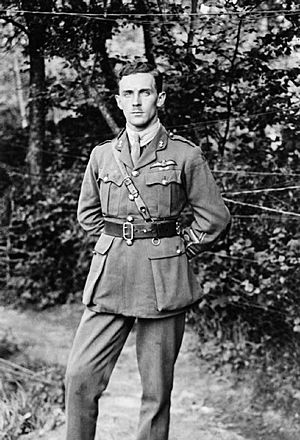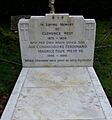Freddie West facts for kids
Quick facts for kids
Freddie West
|
|
|---|---|

West in 1918
|
|
| Born | 19 January 1896 Paddington, London |
| Died | 8 July 1988 (aged 92) Windsor, Berkshire |
| Buried |
Holy Trinity Churchyard, Sunningdale
|
| Allegiance | United Kingdom |
| Service/ |
British Army (1914–18) Royal Air Force (1918–46) |
| Years of service | 1914–1946 |
| Rank | Air Commodore |
| Unit | Royal Army Medical Corps Royal Munster Fusiliers Royal Flying Corps |
| Commands held | No. 50 Wing RAF (1939–40) RAF Odiham (1938–40) No. 4 Squadron RAF (1933–36) |
| Battles/wars | First World War Second World War |
| Awards | Victoria Cross Commander of the Order of the British Empire Military Cross Mentioned in Despatches Knight of the Legion of Honour (France) Commander of the Order of Orange-Nassau (Netherlands) Commander of the Order of the Crown of Italy |
Air Commodore Ferdinand Maurice Felix West, known as "Freddie," was a brave pilot and a high-ranking officer in the Royal Air Force. He was born on January 19, 1896, and passed away on July 8, 1988. He received the Victoria Cross, which is the highest award for incredible bravery in battle for British and Commonwealth soldiers.
Contents
Early Life and Family
Freddie West was born in Paddington, London, on January 19, 1896. His father was an army officer who sadly died in 1902 during the Second Boer War. Freddie's mother, Clemence, was French. After his father's death, Freddie and his mother moved to Milan, Italy.
In 1913, he began studying International Law at the University of Genoa. During a break in 1914, he worked at a bank in Zurich. Interestingly, his mother and aunt were friends with Monsignor Achille Ratti, who later became Pope Pius XI. Young Freddie even went climbing with the future Pope!
Serving in the First World War
When the First World War began in 1914, Freddie joined the British Army. He first served as a private in the Royal Army Medical Corps. In May 1915, he became an officer and joined the Royal Munster Fusiliers. He arrived in France in November 1915 to serve on the Western Front.
Becoming a Pilot
After taking a flight in early 1917, Freddie decided he wanted to fly. He transferred to the Royal Flying Corps and trained as an observer. In April 1917, he returned to France with No 3 Squadron. By July 1917, he was a fully qualified observer, having flown over 100 hours.
After six months and 225 flying hours, he went back to Britain for pilot training. In January 1918, he joined No 8 Squadron. He flew missions to help soldiers and tanks on the ground. In March, he teamed up with Lt. William Haslam. They flew many dangerous missions over the front lines. Both men were awarded the Military Cross on May 1, 1918, for their bravery.
On April 21, 1918, Freddie West and his observer saw the very last fight of Manfred von Richthofen. Richthofen was Germany's most famous fighter pilot, also known as the "Red Baron."
Daring Escapes
Freddie West was known for his amazing flying skills. On June 18, 1918, four German fighter planes attacked his aircraft. Freddie shot one down and cleverly escaped the others. The very next day, a group of German planes surprised him. Freddie quickly dropped to a very low height of 200 feet. He then flew through a dangerous area filled with observation balloons to get away safely.
Receiving the Victoria Cross
Freddie West was 22 years old and a captain in No. 8 Squadron when he earned the Victoria Cross. This happened during the First World War.
On August 12, 1918, the British Army planned a big attack. They needed to know where the enemy was. Freddie and his observer, Lt. William Haslam, took off at dawn in their Armstrong Whitworth FK 8 plane. They spotted many enemy soldiers through a gap in the mist.
Suddenly, they came under heavy fire from the ground. Then, seven German fighter planes attacked them. Freddie was hit in the leg, and his radio was destroyed. Even though he was hurt, he kept flying to identify the enemy's location. He flew so skillfully that his observer could shoot at the German planes, making them leave.
Only when he was sure of the enemy's exact position did he try to fly back to his own lines. He twisted his trouser leg to make a tourniquet and stop the bleeding from his wounds. He couldn't make it back to his airfield, so he landed behind Allied lines. Despite being in terrible pain, he insisted on reporting what he had seen. His left leg had five wounds, one of which had shattered a bone and cut an important artery. His leg had to be amputated.
Soon after, he was sent back to Britain. On November 9, 1918, he learned he had been awarded the Victoria Cross. After recovering, Freddie was fitted with a special artificial leg from Switzerland.
Life in the Royal Air Force
In 1919, Freddie West was given a permanent job in the Royal Air Force (RAF). He was stationed at RAF Uxbridge and slowly returned to flying. In 1936, he commanded No. 4 Squadron RAF. Later, he became an Air Attache to Finland and the Baltic States. This meant he was a military expert working at the British Embassy. He helped Finland buy Bristol Blenheim light bomber planes in 1938.
During the Second World War, he commanded No. 50 Wing in France in late 1939. He then worked at the British Embassy in Rome in early 1940. After that, he was part of the British group in Berne, Switzerland. There, he helped Allied airmen who had escaped into Switzerland. The German Gestapo even put a reward on his head because of his secret activities!
At the end of the war, he was awarded a Commander of the Order of the British Empire (CBE) for his important work.
After the Wars
Freddie West reached the high rank of air commodore. After the war ended in Europe, he retired from the RAF in January 1946. He then joined a film distribution company called J. Arthur Rank Film Distributors, working in overseas sales. He became the managing director in 1947 and retired as chairman in 1958.
Freddie West's Victoria Cross medal is on display at the Imperial War Museum in London.
Images for kids


